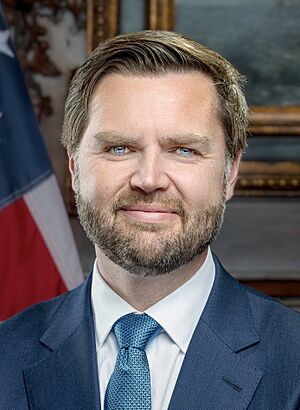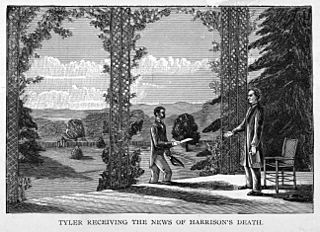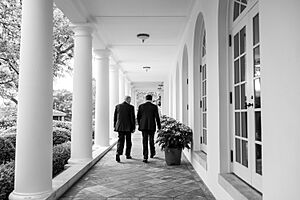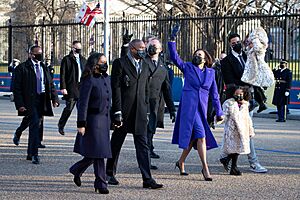Vice President of the United States facts for kids
Quick facts for kids Vice President of the United States |
|
|---|---|
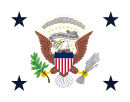
Vice presidential flag
|
|
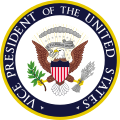
Vice presidential seal
|
|
|
|
| Style |
|
| Member of |
|
| Residence | Number One Observatory Circle |
| Seat | Washington, D.C. |
| Appointer | Electoral College, or, if vacant, President of the United States via congressional confirmation |
| Term length | Four years, no term limit |
| Constituting instrument | Constitution of the United States |
| Formation | March 4, 1789 |
| First holder | John Adams |
| Succession | First |
| Salary | $284,600 per annum |
The vice president of the United States (often called VPOTUS or veep) is a very important leader in the U.S. federal government. This person is the second-highest official in the executive branch, right after the president of the United States. If something happens to the president, the vice president is first in line to take over.
The vice president also has a special role in the legislative branch. They serve as the president of the Senate. This means they lead meetings in the United States Senate. However, they can only vote if there is a tie.
People in the United States choose the vice president. This happens through the Electoral College. The vice president is elected for a four-year term. Since 1967, if the vice president's office becomes empty, the president can choose a new one. This choice must be approved by Congress.
Today, the vice president's job is very powerful. They are a key part of the president's team. The person running for president usually picks their vice president candidate. This person is called their running mate. While the job changes with each president, most vice presidents are important advisors. They also help represent the president. The vice president is also a member of the United States Cabinet and the United States National Security Council. This means they help with important government and safety decisions.
The role of the vice president has changed a lot over time. It started in 1787 at the Constitutional Convention. At first, it was not seen as a very important job. But over the years, it grew in power. The Office of the Vice President was created in 1939. Since the 1970s, the vice president has had an official home. This home is at Number One Observatory Circle.
The Constitution does not clearly say which part of the government the vice president belongs to. Some experts debate if it's the executive, legislative, or both. Today, most people see the vice president as part of the executive branch. This is because presidents often give them executive duties. Many vice presidents have worked in Congress before. They often help the president with new laws. JD Vance is the 50th and current vice president. He started his term on January 20, 2025.
Contents
How the Vice President's Role Developed
Creating the Office
The idea for a vice president came late in the 1787 Constitutional Convention. A special committee suggested how to elect the president. They also decided the Senate would choose its own leader. This leader would take over if the president could not serve.
The framers of the Constitution thought electors would pick someone from their own state. So, they made the vice president's job. Electors had to vote for two people. At least one had to be from outside their state. This was to make sure a national leader was chosen. The person who came in second place would become vice president.
The original plan was in Article II, Section 1, Clause 3. Each state got electors based on its number of representatives and senators. Electors voted for two people for president. They could not pick a first or second choice. The person with the most votes became president. The person with the next most votes became vice president.
Early Vice Presidents and the Twelfth Amendment

The first two vice presidents were John Adams and Thomas Jefferson. They both became vice president by coming in second. They often led Senate meetings. But political parties soon changed things.
In the election of 1796, John Adams became president. But his rival, Thomas Jefferson, became vice president. They were from different parties. Jefferson used his role to challenge Adams's plans.
Then, in the election of 1800, Jefferson and Aaron Burr tied. Jefferson finally won the presidency after many votes. Burr became vice president. This showed the system needed fixing. So, the Twelfth Amendment was added. This amendment made electors vote separately for president and vice president. It was used starting in the 1804 election.
The Vice President's Role in the 19th and Early 20th Centuries
For a long time, the vice president's job was not seen as important. John Adams, the first vice president, felt his job was "insignificant." Thomas R. Marshall, a vice president from 1913 to 1921, joked that a vice president was rarely heard from again.
Some vice presidents, like Garret Hobart, were important advisors. Hobart was called "Assistant President." But until 1919, vice presidents usually did not attend Cabinet meetings. President Woodrow Wilson changed this by asking Thomas R. Marshall to lead meetings when Wilson was away. Later, President Warren G. Harding and President Herbert Hoover also invited their vice presidents to Cabinet meetings.
The Modern Vice Presidency
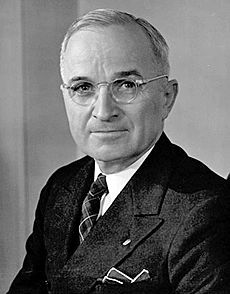
In 1933, President Franklin D. Roosevelt started inviting the vice president to Cabinet meetings again. Every president since has continued this. Roosevelt's first vice president, John Nance Garner, disagreed with him on some issues.
Harry Truman became vice president in 1945. He was not told about important war plans, like the Manhattan Project. When Roosevelt died, Truman became president. He felt like "the moon, the stars and all the planets fell on me." Truman wanted future vice presidents to be better informed. So, in 1949, he made the vice president a member of the United States National Security Council. He also made sure they got regular security briefings.
The vice presidency grew even more important with Richard Nixon (1953–1961). President Dwight Eisenhower let Nixon lead Cabinet meetings when he was away. Nixon also traveled the world.
Before 1961, vice presidents had offices on Capitol Hill. Lyndon B. Johnson was the first vice president to also get an office in the Old Executive Office Building near the White House. President Jimmy Carter was the first to give his vice president, Walter Mondale, an office in the West Wing of the White House. This showed that Carter wanted his vice president to be deeply involved in decisions.
The way presidential candidates are chosen also helped the vice president's role grow. More primary elections meant more strong candidates. Sometimes, those who didn't win the top spot became good vice presidential choices.
By the 2000s, vice presidents like Dick Cheney had a lot of power. This led some to suggest changing the office. But others, like Joe Biden, believed the presidency was too big for one person.
Vice President's Constitutional Duties
The Constitution gives the vice president a few main duties. These duties have been clarified over time.
Leading the Senate
Article I, Section 3, Clause 4 calls the vice president the "President of the Senate." This means they lead Senate meetings. They make sure rules are followed and recognize who can speak. The vice president can also cast a tie-breaking vote if the Senate is evenly split. Kamala Harris has cast the most tie-breaking votes, with 33.
The Constitution also says the Senate can choose a president pro tempore. This person leads Senate meetings when the vice president is not there. Today, other senators often lead meetings instead of the vice president or president pro tempore. The vice president usually does not speak in Senate debates.
Leading Impeachment Trials
As president of the Senate, the vice president can lead most impeachment trials of federal officials. But if the president of the United States is on trial, the chief justice of the United States must lead. This is to avoid any unfairness. No vice president has ever been impeached.
Counting Electoral Votes
The Twelfth Amendment says the vice president receives the Electoral College votes. Then, in front of both the Senate and House of Representatives, they open the sealed votes. Congress then counts these votes. The vice president's role here is mostly to announce the results.
Four vice presidents have announced their own election as president. These include John Adams in 1797 and Thomas Jefferson in 1801. Four vice presidents have also announced their opponent's election. This includes Richard Nixon in 1961 and Kamala Harris in 2025.
Taking Over for the President
Article II, Section 1, Clause 6 says the vice president takes over the president's duties if the president is removed, dies, resigns, or cannot do their job. At first, it was not clear if the vice president became president or just acted as president.
This was first tested in 1841 when President William Henry Harrison died. His vice president, John Tyler, said he was now the president. He took the oath and acted as the full president. Congress eventually agreed with him. This "Tyler Precedent" was made official by the Twenty-fifth Amendment in 1967.
Nine vice presidents have become president during their term. These include John Tyler, Theodore Roosevelt, and Harry S. Truman. Four of them were later elected to their own full terms.
Four sitting vice presidents have been elected president. These are John Adams (1796), Thomas Jefferson (1800), Martin Van Buren (1836), and George H. W. Bush (1988). Two former vice presidents have also won the presidency: Richard Nixon (1968) and Joe Biden (2020). In total, 15 vice presidents have become president.
Acting as President
Sections 3 and 4 of the Twenty-fifth Amendment deal with times when the president cannot lead. This might be due to surgery, illness, or injury. Section 3 is for when the president says they cannot lead. Section 4 is for when the vice president and Cabinet say the president cannot lead.
Section 3 has been used four times by three presidents. On November 19, 2021, Kamala Harris became the first woman in U.S. history to have presidential powers and duties. These sections were added to make it clear what happens if a president is unable to serve. Before, presidents might be very sick, but no one would take over.
Modern Roles of the Vice President
Today, the vice president's power comes from the president and Congress. The vice president has many duties. These include helping with policies, advising the president, and representing the U.S. government. The vice president's influence depends on their relationship with the president.
Presidential Advisor
Most recent vice presidents have been important advisors to the president. Walter Mondale wanted to be a "general adviser" to President Carter. Al Gore advised President Bill Clinton on foreign policy and the environment. Dick Cheney was a very close advisor to President George W. Bush. Joe Biden asked President Barack Obama to let him be the "last person in the room" for big decisions. Later, as president, Biden did the same with Vice President Kamala Harris.
Governing Partner
Presidents have given recent vice presidents important tasks to handle on their own. Joe Biden has said the presidency is "too big anymore for any one man or woman." Dick Cheney often made policy decisions without the president's direct knowledge. Obama asked Biden to oversee policy in Iraq. In 2020, Donald Trump asked Mike Pence to lead the response to COVID-19. In 2021, President Biden put Kamala Harris in charge of issues at the U.S.–Mexico border.
Connecting with Congress
The vice president often helps the president work with Congress. This is especially true if the president has not served in Congress much. Vice presidents are often chosen because they have good relationships with lawmakers. Examples include Richard Nixon, Lyndon Johnson, and Joe Biden. Dick Cheney held weekly meetings with members of Congress. Kamala Harris played a key role in passing laws when the Senate was evenly split.
Representing the Nation
The president is both the head of state and head of government. The vice president often handles the ceremonial duties of the head of state. The vice president might represent the president at funerals abroad or at events in the U.S. This is often the most visible part of their job. They also meet with leaders from other countries.
National Security Council Member
Since 1949, the vice president has been a member of the National Security Council. Harry Truman made this change. He realized that a vice president needed to know about important national security issues. Modern vice presidents are included in daily intelligence briefings. They also attend meetings in the Situation Room with the president.
How Vice Presidents Are Chosen
Who Can Be Vice President?
To be vice president, a person must meet the same rules as the president. They must:
- Be a natural-born U.S. citizen.
- Be at least 35 years old.
- Have lived in the U.S. for at least 14 years.
A person cannot be vice president if they have been removed from federal office by impeachment. Also, if someone has sworn an oath to support the Constitution and then rebelled against the U.S., they cannot serve. This rule was first aimed at supporters of the Confederacy. Congress can remove this disqualification with a two-thirds vote.
Nomination Process
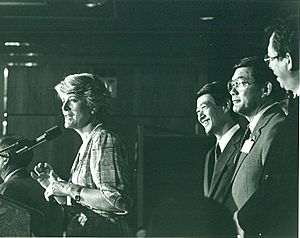
The major political parties choose their vice presidential candidates at their conventions. This happens after the presidential candidate is chosen. The process is similar to choosing the presidential candidate.
Today, the presidential candidate usually picks their running mate. This choice is then approved by the convention. Before 1940, this was rare. In recent years, the vice presidential choice is often announced before the convention even starts.
Choosing a Running Mate
Vice presidential candidates do not need political experience. But most are current or former senators or representatives. Some are governors or high-ranking military officers. The vice presidential candidate must be from a different state than the presidential candidate. This is because of a rule in the Twelfth Amendment.
Often, the presidential candidate picks a vice president who balances the ticket. This might mean someone from a different region or with different political views. They might also pick someone who has qualities the presidential candidate lacks. Or someone who is well-known. Popular candidates who lost the presidential nomination are often considered. This helps unite the party.
Historically, vice presidential nominees were often less important politicians. They were chosen to please certain groups or win key states. A study from 2016 found that vice presidential candidates helped their ticket win about 2.67% more votes in their home states.
The Election Process

The vice president is elected by the Electoral College. This group of electors is formed every four years. Each state gets electors based on its total number of representatives and senators. The Twenty-third Amendment gives the District of Columbia electors too.
On Election Day, people vote for president and vice president. In almost all states, the ticket that wins the most popular votes in that state gets all of its electors. Maine and Nebraska are different. They give two electors to the statewide winner and one to the winner in each congressional district.
About six weeks after the election, the electors meet in their states. They vote for president and vice president separately. In early January, Congress counts these votes. A candidate needs a majority of electoral votes (currently 270 out of 538) to win. If no one gets a majority, the Senate chooses the vice president. Senators vote individually. They need a majority of senators (currently 51 out of 100) to win.
This has only happened once for vice president. In 1837, Richard M. Johnson was elected vice president by the Senate.
Time in Office
Starting the Term
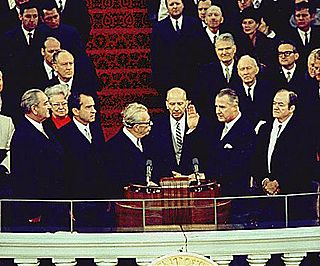
The vice president's term starts at noon on January 20. This is called Inauguration Day. The first terms to start on this date were in 1937. Before that, Inauguration Day was on March 4.
Since 1937, the vice president takes their oath of office on the Capitol steps. This happens right before the president's swearing-in. The Constitution has a specific oath for the president. But for the vice president, it only says they must swear to support the Constitution. The oath used since 1884 is:
I, (first name last name), do solemnly swear (or affirm) that I will support and defend the Constitution of the United States against all enemies, foreign and domestic; that I will bear true faith and allegiance to the same; that I take this obligation freely, without any mental reservation or purpose of evasion; and that I will well and faithfully discharge the duties of the office on which I am about to enter. So help me God.
Length of Term
The vice president serves for four years. There is no limit on how many times a person can be elected vice president. This means someone could serve under different presidents. This has happened twice. George Clinton served under two presidents. John C. Calhoun also served under two different presidents.
Impeachment
Article II, Section 4 of the Constitution allows federal officials, including the vice president, to be removed from office. This can happen for "treason, bribery, or other high crimes and misdemeanors." No vice president has ever been impeached.
When the Office is Empty
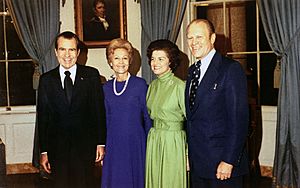
Before 1967, there was no rule for filling an empty vice presidency. If the office became empty, it stayed empty until the next election. Between 1812 and 1965, the vice presidency was empty 16 times. This was due to deaths, one resignation, and eight times when the vice president became president.
Section 2 of the Twenty-fifth Amendment changed this. It says that if the vice president's office is empty, the president chooses a new vice president. This person takes office after being approved by both houses of Congress. This has happened twice. In 1973, Gerald Ford became vice president after Spiro Agnew resigned. In 1974, Nelson Rockefeller became vice president after Ford became president.
| No. | Period of vacancy | Cause of vacancy | Length | Vacancy filled by |
|---|---|---|---|---|
| 1 | April 20, 1812 – March 4, 1813 |
Death of George Clinton | 318 days | Election of 1812 |
| 2 | November 23, 1814 – March 4, 1817 |
Death of Elbridge Gerry | 2 years, 101 days | Election of 1816 |
| 3 | December 28, 1832 – March 4, 1833 |
Resignation of John C. Calhoun | 66 days | Election of 1832 |
| 4 | April 4, 1841 – March 4, 1845 |
Accession of John Tyler as president | 3 years, 334 days | Election of 1844 |
| 5 | July 9, 1850 – March 4, 1853 |
Accession of Millard Fillmore as president | 2 years, 238 days | Election of 1852 |
| 6 | April 18, 1853 – March 4, 1857 |
Death of William R. King | 3 years, 320 days | Election of 1856 |
| 7 | April 15, 1865 – March 4, 1869 |
Accession of Andrew Johnson as president | 3 years, 323 days | Election of 1868 |
| 8 | November 22, 1875 – March 4, 1877 |
Death of Henry Wilson | 1 year, 102 days | Election of 1876 |
| 9 | September 19, 1881 – March 4, 1885 |
Accession of Chester A. Arthur as president | 3 years, 166 days | Election of 1884 |
| 10 | November 25, 1885 – March 4, 1889 |
Death of Thomas A. Hendricks | 3 years, 99 days | Election of 1888 |
| 11 | November 21, 1899 – March 4, 1901 |
Death of Garret Hobart | 1 year, 103 days | Election of 1900 |
| 12 | September 14, 1901 – March 4, 1905 |
Accession of Theodore Roosevelt as president | 3 years, 171 days | Election of 1904 |
| 13 | October 30, 1912 – March 4, 1913 |
Death of James S. Sherman | 125 days | Election of 1912 |
| 14 | August 2, 1923 – March 4, 1925 |
Accession of Calvin Coolidge as president | 1 year, 214 days | Election of 1924 |
| 15 | April 12, 1945 – January 20, 1949 |
Accession of Harry S. Truman as president | 3 years, 283 days | Election of 1948 |
| 16 | November 22, 1963 – January 20, 1965 |
Accession of Lyndon B. Johnson as president | 1 year, 59 days | Election of 1964 |
| 17 | October 10, 1973 – December 6, 1973 |
Resignation of Spiro Agnew | 57 days | Confirmation of successor |
| 18 | August 9, 1974 – December 19, 1974 |
Accession of Gerald Ford as president | 132 days | Confirmation of successor |
Life as Vice President
Salary and Home
In 2024, the vice president's salary is $284,600. However, due to a pay freeze, the actual amount paid is $235,100. The vice president does not get a special pension just for being vice president. They get the same pension as other members of Congress. To get a pension, they must serve at least two years.
Since 1974, the vice president has an official home. It is called Number One Observatory Circle. It is in Washington, D.C.. Before this, vice presidents lived in their own homes or apartments. The mansion was built in 1893. It was first for the superintendent of the U.S. Naval Observatory. Then it was for the Chief of Naval Operations. In 1974, it became the vice president's home.
Travel and Security

For long trips, the vice president uses one of two special Boeing 757 airplanes. These are called Air Force Two when the vice president is on board. For shorter trips, the vice president uses U.S. Marine Corps helicopters. These are called Marine Two when the vice president is on board. Several helicopters often fly together for safety.
The U.S. Secret Service protects the vice president and their family. They use special code names for security reasons.
Office Spaces
The vice president uses several offices. They have an office in the West Wing of the White House. They also have a ceremonial office in the Eisenhower Executive Office Building. This is where most of their staff works. They have an office in the United States Capitol for meetings with Congress members. They also have an office at their home.
After Being Vice President
Since 1977, former vice presidents who are elected to the Senate can be called Deputy President pro tempore. So far, only Hubert Humphrey has held this title. All former vice presidents also get a portrait bust in the Senate wing of the Capitol. This honors their service.
Unlike former presidents, former vice presidents get retirement pay based on their role as president of the Senate. Since 2008, former vice presidents and their families get Secret Service protection for up to six months after leaving office. They can also get temporary protection later if needed.
Images for kids
-
Vice President Joe Biden meets with President Barack Obama in the Oval Office, 2011.
-
Vice President Kamala Harris meets with President Joe Biden in the Oval Office, 2022.
See also
 In Spanish: Vicepresidente de los Estados Unidos para niños
In Spanish: Vicepresidente de los Estados Unidos para niños


